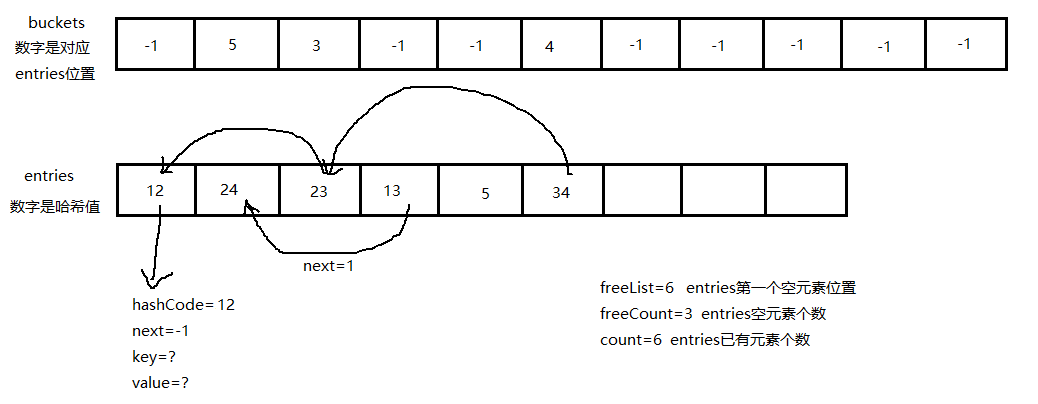原帖
通过查阅网上相关资料和查看微软源码,我对Dictionary有了更深的理解。
Dictionary,翻译为中文是字典,通过查看源码发现,它真的内部结构真的和平时用的字典思想一样。
我们平时用的字典主要包括两个两个部分,目录和正文,目录用来进行第一次的粗略查找,正文进行第二次精确查找。通过将数据进行分组,形成目录,正文则是分组后的结果。
而Dictionary对应的是 int[] buckets 和 Entry[] entries,buckets用来记录要查询元素分组的起始位置(这么些是为了方便理解,其实是最后一个插入元素的位置没有元素为-1,查找同组元素通过 entries 元素中的 Next 遍历,后面会提到),entries记录所有元素。分组依据是计算元素 Key 的哈希值与 buckets 的长度取余,余数就是分组,指向buckets 位置。通过先查找 buckets 确定元素分组的起始位置,再遍历分组内元素查找到准确位置。与对应的目录和正文相同,buckets的 长度大于等于 entries(我理解是为扩展做准备的),buckets 的长度使用 HashHelpers.GetPrime(capacity) 计算,是一个计算得到的最优值。capacity是字典的容量,大于等于字典中实际存储元素个数。
Dictionary与真实的字典不同之处在于,真实字典的分组结果的物理位置是连续的,而 Dictionary 不是,他的物理位置顺序就是插入的顺序,而分组信息记录在 entries 元素中的 Next 中,Next 是个 int 字段,用来记录同组元素的下一个位置(若当前为该组第一个插入元素则记录-1,第一个插入元素在分组遍历的最后一个)
解析一下Dictionary的几个关键方法
1.Add(Insert 新增&更新方法)
Add和使用[]更新实际就是调用的Insert,代码如下。
首先计算key的哈希值,与buckets取余后确定目录位置,找到entries的位置,然后通过.next方式遍历分组内元素,确定是否存在同key元素,再进行新增或更新操作
Add:
public void Add(TKey key, TValue value){Insert(key, value, true);}
索引器:
public TValue this[TKey key]{get{int i = FindEntry(key);if (i >= 0) return entries[i].value;ThrowHelper.ThrowKeyNotFoundException();return default(TValue);}set{Insert(key, value, false);}}
Insert:
private void Insert(TKey key, TValue value, bool add){if (key == null){ThrowHelper.ThrowArgumentNullException(ExceptionArgument.key);}if (buckets == null) Initialize(0);int hashCode = comparer.GetHashCode(key) & 0x7FFFFFFF;int targetBucket = hashCode % buckets.Length;#if FEATURE_RANDOMIZED_STRING_HASHINGint collisionCount = 0;#endiffor (int i = buckets[targetBucket]; i >= 0; i = entries[i].next){if (entries[i].hashCode == hashCode && comparer.Equals(entries[i].key, key)){if (add){ThrowHelper.ThrowArgumentException(ExceptionResource.Argument_AddingDuplicate);}entries[i].value = value;version++;return;}#if FEATURE_RANDOMIZED_STRING_HASHINGcollisionCount++;#endif}int index;if (freeCount > 0){index = freeList;freeList = entries[index].next;freeCount--;}else{if (count == entries.Length){Resize();targetBucket = hashCode % buckets.Length;}index = count;count++;}entries[index].hashCode = hashCode;entries[index].next = buckets[targetBucket];entries[index].key = key;entries[index].value = value;buckets[targetBucket] = index;version++;#if FEATURE_RANDOMIZED_STRING_HASHING#if FEATURE_CORECLR// In case we hit the collision threshold we'll need to switch to the comparer which is using randomized string hashing// in this case will be EqualityComparer<string>.Default.// Note, randomized string hashing is turned on by default on coreclr so EqualityComparer<string>.Default will// be using randomized string hashingif (collisionCount > HashHelpers.HashCollisionThreshold && comparer == NonRandomizedStringEqualityComparer.Default){comparer = (IEqualityComparer<TKey>) EqualityComparer<string>.Default;Resize(entries.Length, true);}#elseif(collisionCount > HashHelpers.HashCollisionThreshold && HashHelpers.IsWellKnownEqualityComparer(comparer)){comparer = (IEqualityComparer<TKey>) HashHelpers.GetRandomizedEqualityComparer(comparer);Resize(entries.Length, true);}#endif // FEATURE_CORECLR#endif}
FindEntry:
private int FindEntry(TKey key) {if( key == null) {ThrowHelper.ThrowArgumentNullException(ExceptionArgument.key);}if (buckets != null) {int hashCode = comparer.GetHashCode(key) & 0x7FFFFFFF;for (int i = buckets[hashCode % buckets.Length]; i >= 0; i = entries[i].next) {if (entries[i].hashCode == hashCode && comparer.Equals(entries[i].key, key)) return i;}}return -1;}
2.Resize(重新调整大小)
虽然这是个私有方法,但我认为关键。它会在元素个数即将超过容量时调用,代码如下,简单说明一下。
该方法会声明一个 newBuckets 和 newEntrues 用来替换之前的 buckets 和 entrues,声明后会重构这两个数组,将 entrues 的值复制到 entrues,重新计算 newBuckets 的值,如果频繁触发该方法消耗是较大的,所以创建 Dictionary 时建议指定合理的 capacity(容量)
private void Resize(int newSize, bool forceNewHashCodes){Contract.Assert(newSize >= entries.Length);int[] newBuckets = new int[newSize];for (int i = 0; i < newBuckets.Length; i++) newBuckets[i] = -1;Entry[] newEntries = new Entry[newSize];Array.Copy(entries, 0, newEntries, 0, count);if (forceNewHashCodes){for (int i = 0; i < count; i++){if (newEntries[i].hashCode != -1){newEntries[i].hashCode = (comparer.GetHashCode(newEntries[i].key) & 0x7FFFFFFF);}}}for (int i = 0; i < count; i++){if (newEntries[i].hashCode >= 0){int bucket = newEntries[i].hashCode % newSize;newEntries[i].next = newBuckets[bucket];newBuckets[bucket] = i;}}buckets = newBuckets;entries = newEntries;}
3.Remove(移除)
依据key查到元素,将元素赋值为初始值,freeList记录该位置,下次新增会填充该位置
public bool Remove(TKey key){if (key == null){ThrowHelper.ThrowArgumentNullException(ExceptionArgument.key);}if (buckets != null){int hashCode = comparer.GetHashCode(key) & 0x7FFFFFFF;int bucket = hashCode % buckets.Length;int last = -1;for (int i = buckets[bucket]; i >= 0; last = i, i = entries[i].next){if (entries[i].hashCode == hashCode && comparer.Equals(entries[i].key, key)){if (last < 0){buckets[bucket] = entries[i].next;}else{entries[last].next = entries[i].next;}entries[i].hashCode = -1;entries[i].next = freeList;entries[i].key = default(TKey);entries[i].value = default(TValue);freeList = i;freeCount++;version++;return true;}}}return false;}
效率对比
新增效率:
| 时间ms | |
|---|---|
| Dictionary | 0.5643 |
| Array | 0.0238 |
| List | 0.0853 |
这是新增10000个元素操作耗费时间,Dictionary要比Array和List差不多高一个数量级。Array耗时最小是因为最开始就把所有空间申请好了。
查询效率:
| 10 | 100 | 1000 | 10000 | |
|---|---|---|---|---|
| Dictionary | 0.0056 | 0.0062 | 0.0056 | 0.0079 |
| Array遍历 | 0.0022 | 0.0142 | 0.1228 | 1.2396 |
| Array迭代器 | 0.0574 | 0.4278 | 6.1383 | 82.0934 |
| List遍历 | 0.0028 | 0.0238 | 0.2588 | 2.3558 |
| List.Find | 0.0654 | 0.091 | 0.3384 | 2.8768 |
| List迭代器 | 0.0079 | 0.029 | 0.2958 | 3.6625 |
可以看出元素在10个时除了Array迭代器和List.Find外,其他的没有较大差异。Array迭代器耗时的原因是涉及拆箱操作,List.Find可能是Lambda表达式的原因。当元素个数达到100时,Dictionary查询速度就相对快很多。随着元素数量增加,Dictionary查询速度并无太大差异,而其他查询呈倍数增长。
内存对比(元素个数10000)
| 字节差异 | |
|---|---|
| Dictionary | 350456 |
| Array | 40000左右 |
| List | 65572 |
通过VS查看内存情况(太菜了不知道Array对应的内存怎么看,估计40000左右)
附测试代码
测试代码:
using System;using System.Collections.Generic;using Microsoft.VisualStudio.TestTools.UnitTesting;using System.Diagnostics;namespace ToolBoxTest{/// <summary>/// CommonTest 的摘要说明/// </summary>[TestClass]public class CommonTest{[TestMethod]public void Test1(){Stopwatch sw = new Stopwatch();sw.Start();List<int> list = new List<int>();Dictionary<int, int> dic = new Dictionary<int, int>();int count = 10000;int key = count / 2;int[] arr = new int[count];sw.Stop();sw.Restart();for (int i = 0; i < count; i++){arr[i] = i;}sw.Stop();TimeSpan tt1 = sw.Elapsed;sw.Restart();for (int i = 0; i < count; i++){list.Add(i);}sw.Stop();TimeSpan tt2 = sw.Elapsed;sw.Restart();for (int i = 0; i < count; i++){dic.Add(i, i);}sw.Stop();TimeSpan tt3 = sw.Elapsed;//字典sw.Restart();for(int j=0;j<100;j++){int index2 = dic[key];}sw.Stop();TimeSpan ts0 = sw.Elapsed;//数组 遍历sw.Restart();for (int j = 0; j < 100; j++){for (int i = 0; i < count; i++)if (arr[i] == key) break;}sw.Stop();TimeSpan ts11 = sw.Elapsed;//数组 迭代器sw.Restart();for (int j = 0; j < 100; j++){var p = arr.GetEnumerator();while (p.MoveNext()){if ((int)p.Current == key)break;}}sw.Stop();TimeSpan ts12 = sw.Elapsed;//列表 遍历sw.Restart();for (int j = 0; j < 100; j++){for (int i = 0; i < count; i++)if (list[i] == key) break;}sw.Stop();TimeSpan ts21 = sw.Elapsed;//列表 Findsw.Restart();for (int j = 0; j < 100; j++){list.Find(x => x == key);}sw.Stop();TimeSpan ts22 = sw.Elapsed;//列表 迭代器sw.Restart();for (int j = 0; j < 100; j++){var q = list.GetEnumerator();while (q.MoveNext()){if (q.Current == key)break;}}sw.Stop();TimeSpan ts23 = sw.Elapsed;}}}
总结一下
Dictionary 和我们日常用到的字典原理是一样的,通过目录→正文两次查找的方式查找元素,是一种空间换时间的方式,查询效率很高,大多数情况经过2次查询即可查到(需计算hashCode),但是相应的,开辟了多几倍的内存空间。另外,新增效率Dictionary明显较差,所以使用时要分情况而定,查询>新增(编辑)时优先考虑字典,它的查询效率真的很高。
使用注意点:
1.使用前尽量指定合适的容量,字典内元素个数应尽量避免超过容量
2.查询时应避免使用 Contains + [] 的方式取值,建议使用 TryGetValue,因为前者实际上是进行了两次查询,而后者是一次
参考:
https://www.cnblogs.com/zhili/p/DictionaryInDepth.html
https://referencesource.microsoft.com/#mscorlib/system/collections/generic/dictionary.cs


